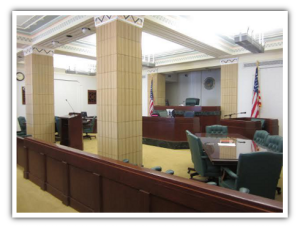We usually think of a courtroom as a large, organized, open space full of litigants and participants undergoing court proceedings with spectators watching from gallery seating. After all, this is how a courtroom appears on TV. What we do not see on TV are the many courtrooms with columns in the space that block the view of the participants. Courtroom sightlines are essential in courthouse planning.
The courtroom sightline is an essential element in design. The most critical courtroom sightline is between the judge, jury, and witness. Yet I have seen columns in courtrooms that obstruct the judge’s view of a portion of the jury or require some of the jury to sit outside the jury box to view the witness. Columns in the well area hinder the proper functioning of a courtroom. If the participants cannot see each other, it distracts them from court proceedings.

It is also essential for the judge to see all people in the courtroom, including the spectators. For security reasons, the judge (and courtroom security personnel) must be able to see everyone to ensure the proceedings are safe. Many courtrooms have columns between the well area and the spectator seating and columns within the spectator seating area.
Such columns create “blind spots” that prevent the judge from seeing everyone and, thus, create undesirable security issues. This is especially problematic in tense criminal proceedings. When the judge has a clear view of the entire courtroom, they can observe the behavior of participants and spectators and, hopefully, prevent problems before they arise.
Obstructed Courtroom Sightline
Despite the importance of having a courtroom free of visual obstructions, I have seen hundreds of courtrooms with columns blocking courtroom sightlines. These courtrooms were often constructed in space that was not originally intended to accommodate a courtroom's entire length and width.
As the need for additional judges and courtrooms increased, there was no suitable space, so the court made do with available space. Having columns in the courtroom is often a necessary compromise because removing or significantly modifying a load-bearing column is cost prohibitive.
Sightline Solutions
In most cases, columns in the courtrooms just need to be accepted. However, with some creative thought, alternative layouts can improve the courtroom sightline in a courtroom with columns. For example, I have seen courtrooms where sightlines could be significantly improved by setting up the judge’s bench in a corner instead of placing it front and center.
The most creative solution I witnessed was in a Tennessee courtroom with a column that obstructed the view of spectators. The court mounted a flat panel monitor on one side of the column and a camera on the opposite side.
By doing so, spectators whose courtroom sightline of the proceedings was blocked could watch the monitor and still see what was happening in the courtroom. You can make the most out of a less-than-ideal courtroom situation with a bit of innovation.





.jpg)
.jpg)
.jpg)
.jpg)
.jpg)
-1.jpg)
.jpg)
.jpg)

